Category: Idaho Military Divison
German soldiers train with Idaho Air National Guard A-10 pilots
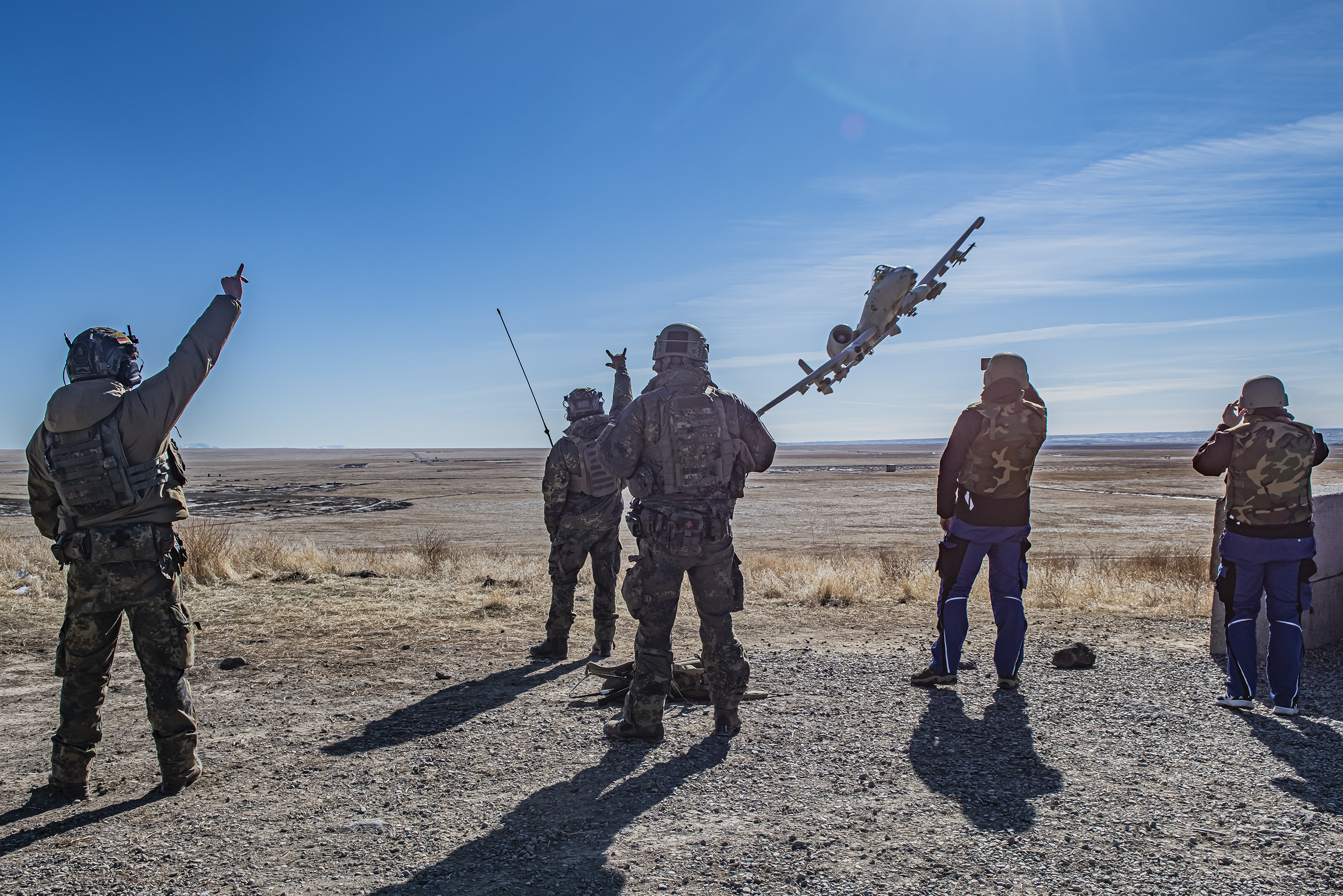
Soldiers from the German Army’s 6th Battery of the Artillery Battalion 345 joined forces with A-10 Thunderbolt II pilots assigned to the 124th Fighter Wing’s 190th Fighter Squadron Feb. 11 to 22, to conduct close air support training at Saylor Creek Range, Idaho.
“The 190th Fighter Squadron supports and encourages this training so we are prepared and familiar with our NATO counterpart’s tactics, techniques, and procedures,” said Lt. Col. Mike “Jack” Hampton, 190th Fighter Squadron commander. “The training also enables us to establish lasting relationships that we can rely on during times of war.”
The visiting soldiers from Idar-Oberstein, Germany, consisted of joint terminal attack controllers, who coordinate, integrate and direct the actions of combat aircraft engaging in close air support operations, and joint fire observers, who augment JTACs by relaying target data. The unit has trained in Idaho annually since 2016.
“The 190th accepts us here, dedicates training to us and improves our tactical training,” said a JTAC instructor from the German Army. “They honor our unit, and I am very proud in the trust that they set in us.”
The joint training between the Idaho Air National Guard and German forces incorporated NATO TTPs utilizing A-10 aircraft to prosecute targets ranging from armor, artillery, bunkers, revetments, aircraft, simulated enemy combatants, moving targets, surface to air threats and more.
“All of these target sets are incorporated into one training range, which delivers unmatched training compared to anywhere else in the world,” said Hampton. “Each training mission is complex and detailed to mirror any future conflicts in or around the European Theater but can also be used in any region of the world.”
Located approximately 43 miles southeast of Gowen Field, Saylor Creek Range offers an impact area three miles wide by six miles long, where air and ground assets can employ live munitions. A joint fires platoon sergeant with the German Army said the training site is unlike anything they have in Germany.
“In Germany, our soldiers never get into realistic situations like they do in Idaho because of training restrictions,” said the platoon sergeant. “Here you can be 500 meters away while a 2,000-pound bomb is flying off the jet. It helps our soldiers to see live munitions hit their targets because then they know what they say to pilots really matters.”
On the range, the German soldiers rehearsed various training scenarios to refine their procedures while both forces worked to hone their joint communication.
Later this year, members of the 124th Fighter Wing will deploy to Germany in support of Air Defender 2023.
One team, one fight: Army and Air join forces for mass casualty, medevac training
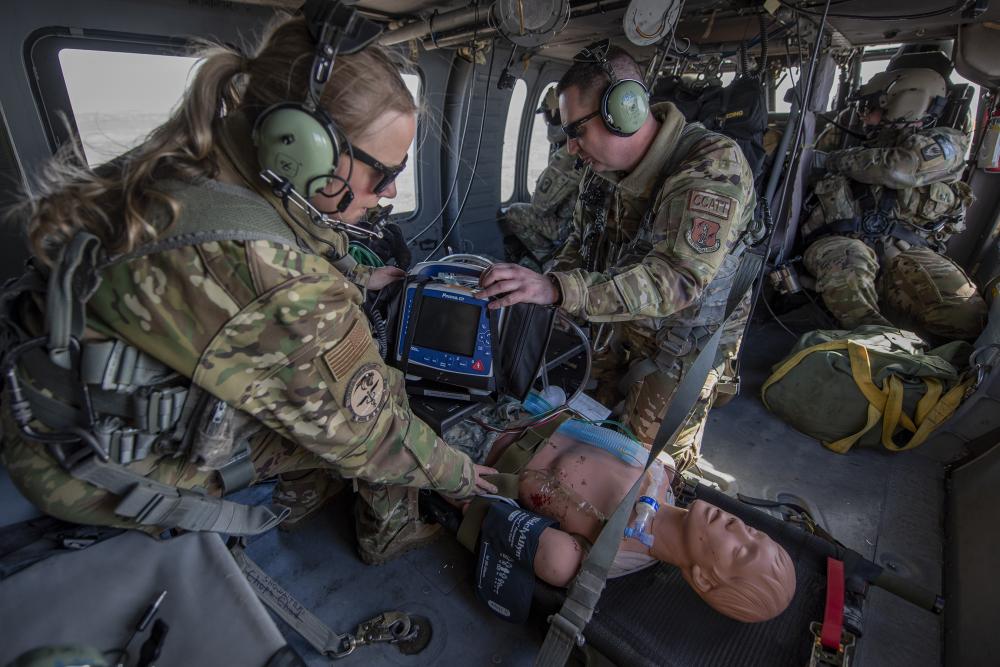
Idaho National Guard Soldiers and Airmen, as well as active duty counterparts joined forces with a one-team, one-fight mentality for joint training during a mass casualty exercise on Feb. 4 near Gowen Field.
“The best way to grow our mindset of becoming more operational and ready for a deployed environment is to train with the nearby resources, such as the Idaho Army National Guard and our active duty counterparts,” said Senior Master Sgt. Virginia Holmgren, a respiratory therapist from the Idaho Air National Guard’s 124th Medical Group. “Forming relationships with the other branches helps us to become familiar with each other’s capabilities and to practice working together because when we are in a deployed environment we will be working with the other branches in the fight.”
Medical personnel from Gowen Field’s 124th Medical Group and active duty medical personnel with the 366th Medical Group from Mountain Home Air Force Base teamed up for several mass casualty events, which also included the use of medevac Soldiers and UH-60 Black Hawk helicopters from the Idaho Army National Guard’s 1st of the 168th Aviation Regiment to participate in the medical evacuation scenarios.
“This exercise is a great example of how the Idaho National Guard is committed to the joint warfighting doctrine in support of the National Defense Strategy,” said Brig. Gen. Tim Donnellan, Idaho Air National Guard commander. “The 124th Medical Group coordinated this incredible training using combat proven units from the Idaho Army National Guard, the Idaho Air National Guard, and the Gunfighters of the 366th Fighter Wing.”
During the scenarios, combat medics performed treatment and stabilized casualties at a field medical tent in a simulated deployed location. The focus for the combat medics during the mass casualty scenarios was an emphasis on Tactical Combat Casualty Care. The TCCC is the military guideline for trauma life support in pre-hospital combat medicine, designed to reduce preventable deaths while continuing to maintain operation success.
“With our new DoD guidelines for the TCCC, it requires us to have more hands-on deck and for more Airmen to be familiar with trauma care in responding to worse injuries out on the field rather than the typical self aid and buddy care that we have focused on in the past,” said Senior Master Sgt. Davis Nguyen, the 124th Medical Group Function Area Manager.
Once medics respond and stabilize casualties, they could then recognize the patients that needed more advanced critical care at a hospital outside of the combat field location and the 9-Line medevac call requesting the Black Hawk medevac team was made. In combat, the 9-Line is an emergency medevac request with an accurate report of combat injuries that is often the difference between life and death.
The ground combat medics and the Black Hawk flight medics worked together to stabilize the casualty during flight until they reached the simulated higher echelon of medical care.
Additional scenarios required protective gear to be worn during a chemical, biological, radiological or nuclear event while Idaho National Guard Soldiers conducted hoist rescue training, allowing Airmen the chance to gain insight into a full range of rescue capabilities of the medevac Soldiers.
“I am proud of the commitment of the men and women in this joint, total force exercise demonstrating the incredible talent and the first class training capabilities we have here in Idaho,” said Donnellan. “We will continue to maintain our readiness for the immediate fight while preparing for any conflicts of the future.”
U.S. Navy Sailors assigned to the USS IDAHO submarine visit Idaho
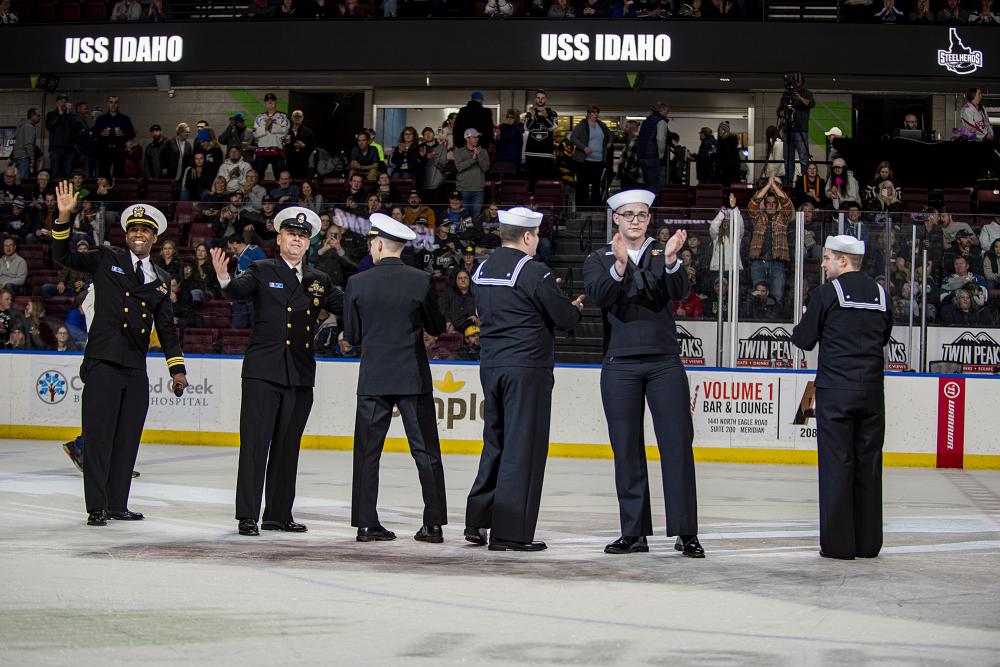
Idahoans from across the state welcomed a contingent of the first U.S. Navy Sailors assigned to the USS IDAHO SSN 799 nuclear powered attack submarine. The USS Idaho Commissioning Committee sponsored the six Sailors’ weeklong tour during the last week in January to the Gem State to encourage them to become familiar with all things Idaho.
Idahoans welcomed Lt. Commander Darrell Smith, Master Chief Petty Officer Travis Skipper, Lt. Beckett Lemley, Machinist Mate 1st Class Justin Teal, Information Technology 2nd Class Peyton Freck and Machinist Mate 3rd Class Gianni Luzzetti across the state.
The Idaho Steelheads recognized the six crewmembers out on the ice during Wednesday’s hockey game and Idahoans got a chance to meet the Sailors at the McCall Winter Carnival. The Sailors spent some time on Gowen Field and met with the Idaho National Guard leadership. Additionally, the crew visited with the late Medal of Honor recipient Art Jackson’s wife Sally Jackson; visited the Idaho State Veterans Cemetery; toured the Idaho Veterans Garden in Caldwell; spoke at school assemblies; attended the USS IDAHO Night at the Boise State University basketball game; visited Idaho Legislature and were introduced to a session of the Idaho State Senate and much more throughout the week.
The purpose of the visit to Idaho is to familiarize the Sailors with the state of Idaho and to establish a bond between Idaho’s citizens and the Sailors who will take the USS IDAHO to sea as a crucial part of the nation’s military strategy.
The future USS IDAHO is a leading-edge Virginia Class nuclear-powered fast attack submarine currently being built by General Dynamics Electric Boat in Connecticut. According to the USS Idaho Commissioning Committee the submarine will be christened this fall and commissioned into the Navy fleet in the fall of 2024.
Idaho’s American Legion holds flag disposal ceremony on Veterans Day
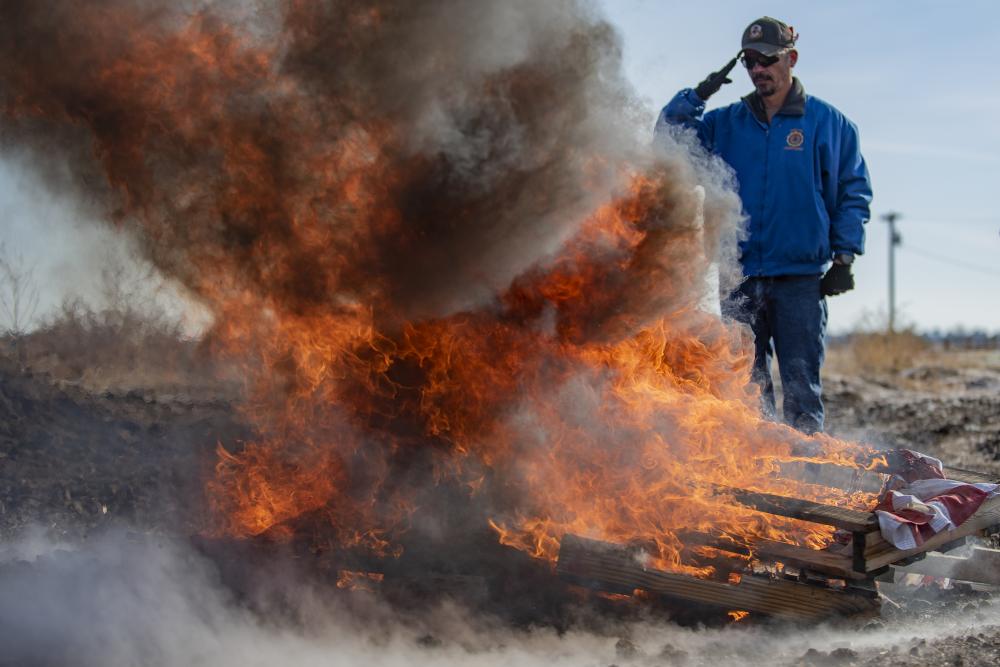
Several members of the American Legion Department of Idaho spent their Veterans Day properly disposing of close to 5,000 American flags by holding a ceremony and respectfully burning the flags.
“I would rather spend my Veterans Day honoring those who served and came before me by taking care of the very flag that they fought so hard to defend and that so many of them many died for,” said Matt Wrobel, commander of the American Legion Department of Idaho. “We could all go out to breakfast or lunch or there are thousands of other events going on today, but this is what I feel passionate about.”
During the ceremony, Idaho National Guard’s trumpet player from the 25th Army Band, Sgt. 1st Class Michael Robinett, performed Retreat to lower and retire the first tattered flag at the beginning of the ceremony. He played Taps to honor and respect the flag as it was burned. Robinett then performed To the Colors for a new flag, as it was raised and displayed.
The flags came from all around Idaho and were ready to be respectfully disposed of due to each flag being faded, tattered or torn. In addition, the Idaho State flag can also be respectfully disposed of and burned along side the American flags.
The American Legion Department of Idaho properly disposes of approximately 10,000 flags each year. Idahoans can dispose of their unserviceable flag by dropping it off at their local government or military bases, Girl or Boy Scout locations, American Legion posts or local Veterans of Foreign Wars posts.
Citizens can express their pride in belonging to America by displaying the American flag, however, when that flag becomes tattered it is time to take it down or replace it according to the U.S. Department of Veterans Affairs. A torn or tattered flag is seen as a dismantled piece of cloth rather than a symbol of American pride.
A small Idaho town makes a big Veteran’s Day impression
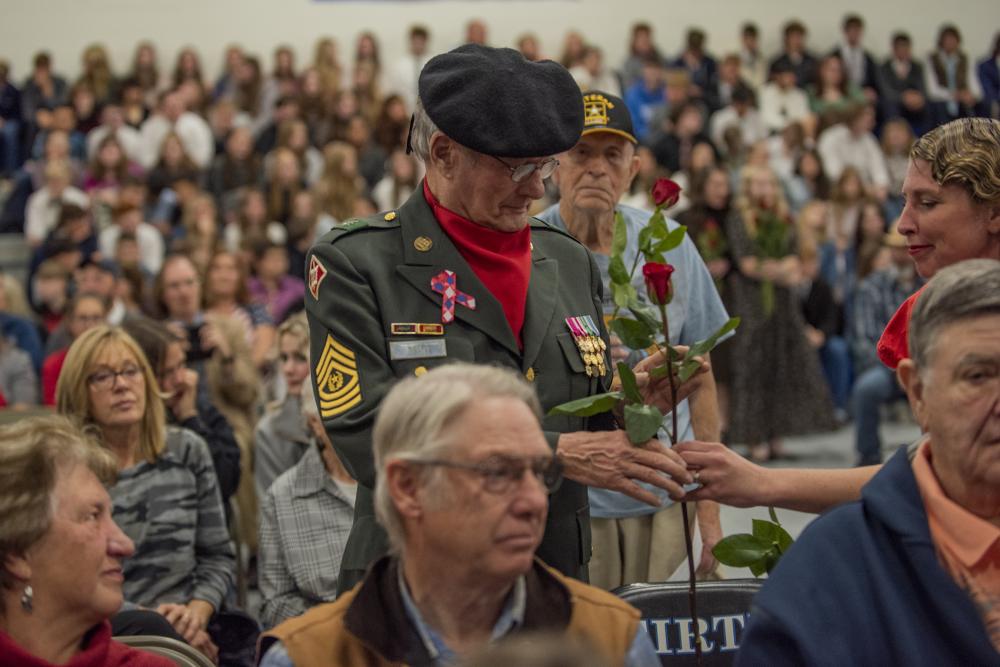
The rural town of Firth held a large Veteran’s Day assembly in Eastern Idaho on Nov. 10th, inviting hundreds of attendees, including Idaho’s adjutant general, Maj. Gen. Michael Garshak.
The assembly honored more than 100 local veterans and their families with help from more than 600 local and surrounding town volunteers, students, teachers and administrators. The assembly was held at Firth High School. The population of the small town is just shy of 600 people, according to the latest United States Census Bureau.
Four Soldiers from the Idaho National Guard’s 148th Field Artillery Regiment posted the flags. Local veterans of all branches and current service members were recognized at the assembly and presented with plaques and roses. Garshak spoke at the assembly about the importance of patriotism.
“Those of us in the military in Idaho are fortunate to serve in a state that truly honors and appreciates military service, and nowhere more so than here in Eastern Idaho,” said Garshak.
He continued. “While Veteran’s Day is an opportunity to thank those who have sacrificed, especially during times of war, where the survival of our nation has hung in the balance, it is also an opportunity to recognize and appreciate the value military service brings to our state, our country and to those who serve.”
Garshak thanked every veteran, past and present, and future veterans, for their service to our nation. He thanked the crowd for their support as well on behalf of the Idaho National Guard and the U.S. military.
Garshak closed his remarks with the takeaway that military service is not all about sacrifice.
“Yes, there are times when it is hard, but that comes with all walks of life,” he said. “I’ve learned that the things we value the most, and bring the greatest reward, are the things that we have worked the hardest for.”
Idaho Soldiers return home from overseas deployment
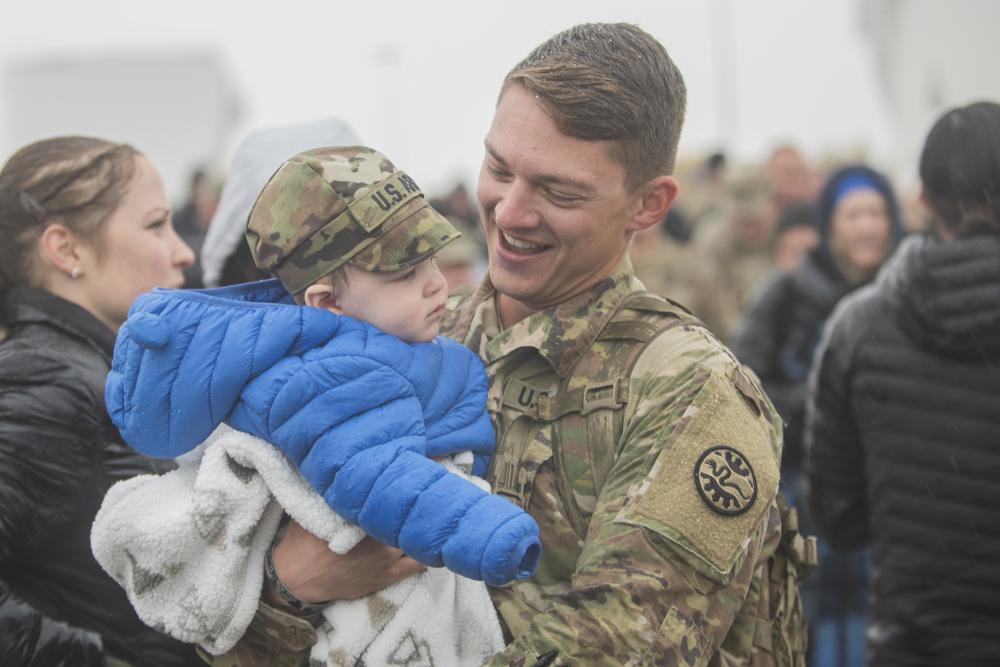
The Idaho Army National Guard welcomed home to Boise, Idaho, nearly 100 116th Cavalry Brigade Combat Team Soldiers on Nov. 4th after a yearlong deployment to Southwest Asia in support of Operation Spartan Shield. An additional 100 other Soldiers returned to their communities elsewhere across the state throughout the day.
“These Soldiers embody what the National Guard is all about: citizen-Soldiers who serve their nation when called upon and return home to their families and communities,” said Brig. Gen. Farin Schwartz, commander, Idaho Army National Guard. “It’s an honor to welcome these Soldiers home and I thank each one of them for their service and dedication to our state and nation. For 10 months, our Soldiers deterred enemy aggression in a very hostile environment, symbolizing our nation’s commitment to our global partners and allies.”
The Soldiers deployed in November 2021 to support the 116th Cavalry Brigade Combat Team’s Task Force Griz, which was headquartered by the Montana Army National Guard and included Soldiers from the Idaho, Montana, Florida and Nevada Army National Guards.
Idaho Soldiers comprised nearly 20 percent of the task force, which spent 10 months overseas, in addition to receiving 45 days of training stateside before deploying.
OSS is a joint mission under the United States Central Command and is part of Operation Enduring Freedom. The task force provided three mission response forces to the CENTCOM commander and conducted missions and training exercises in Iraq, Jordan, the Kingdom of Saudi Arabia, Kuwait, Syria and Qatar.
The task force conducted security and stability operations and demonstrated the U.S.’s continued commitment to deterring adversaries while supporting regional allies. The task force was relieved in October by another 116th CBCT-led task force, including more than 600 Idaho Soldiers, who are expected to return next year.
Task Force Griz Soldiers began returning to Fort Bliss, Texas, Oct. 24 and conducted demobilization activities before returning home.
The 116th CBCT previously deployed in support of the Global War on Terror in 2004 and 2010 to Iraq.
Boise firefighters train Idaho’s Civil Support Team on rope rescue
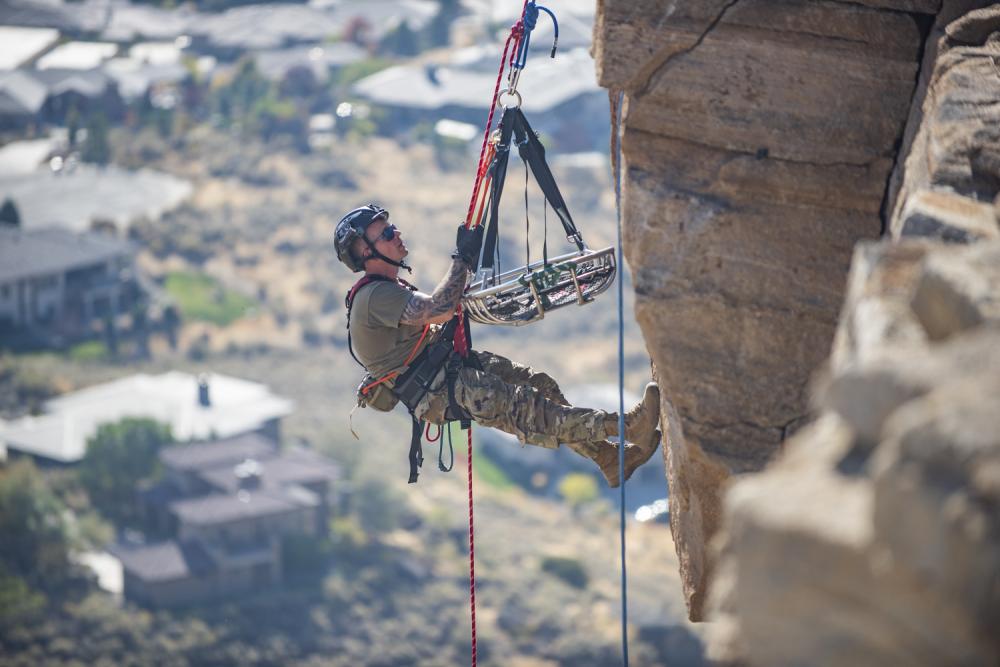
Throughout the month of October, the Idaho National Guard’s 101st Civil Support Team partnered with the Boise Fire Department Technical Rescue Team to participate in a ropes rescue course taught by Boise firefighters. The course, which served as an annual recertification for the CST Guardsmen, entailed two weeklong sessions for the 22-member team and helped the Boise firefighters refine their skills as trainers.
“This training benefits both the Idaho National Guard and us,” said Brent Matthews, captain of the Boise Technical Rescue Team. “Not only are we certifying our partners on ropes rescue training, but our instructors also get valuable experience and more proficient as certifiable instructors.”
The first week, Oct. 10th through the 14th, started with the classroom portion of learning about ropes rescue as a prerequisite for the hands-on portion of the training. Using what they learned about the ropes, the CST Guardsmen rappelled from tops of buildings at the Boise Fire Department’s Fire Training Center.
Once the Guardsmen were proficient at ropes rappelling, they practiced ropes rescues using wire rescue baskets at cliffs near the Table Rock trails in the Boise foothills to simulate a large-scale rescue of multiple people.
“To utilize the CST in ropes rescue, there would be an instance where something serious happened like a natural or man-made disaster or an emergency where the local search and rescue team wouldn’t have enough resources and could call us,” said Lt. Col. Robert Grimes, 101st CST commander.
The second weeklong training, Oct. 24th through 28th, focused on confined space rescues at Boise’s Lucky Peak Power Plant. The training mirrored a scenario where a devastated occurrence or a large-scaled catastrophe, like an earthquake, happened with severe damage to a building that could involve chemicals. This would require HAZMAT precautions, along with a large number of rescues in buildings with confined spaces, and would involve ropes and sked stretchers.
These incidents could be intensified by a lack of oxygen that is available in a non-ventilated area and complicated by the tight confines of the space, requiring rescuers to have air tanks during a rescue.
“Confined space is a rescue of people, for instance, inside of a building, in a tunnel or inside tanks where there could be a HAZMAT situation. They might be injured too badly to get out on their own or they could be unconscious,” said Grimes. “The CST has the capability to respond to weapons of mass destruction and HAZMAT scenarios already. The ropes rescue and confined space training adds another capability for the CST to assist the local fire departments and local agencies.”
The Boise Fire Department Technical Rescue Team is highly trained to handle the emergencies involving ropes rescues and confined space rescues, however, they could call upon their 101st CST partners if the large number of rescues surpassed their limit.
“We’ve been building this relationship and working together for quite a while,” said Matthews. “The CST has really great HAZMAT capabilities. Having the CST already trained at HAZMAT, plus the ropes rescue and confined space training, benefits us as well. In the future, I’d like to see us integrate more in real-world situations. When we have a HAZMAT call with confined spaces, we can call them to assist. I can see us working really closely together in the future.”
Idaho Army National Guard fires precision guided munitions
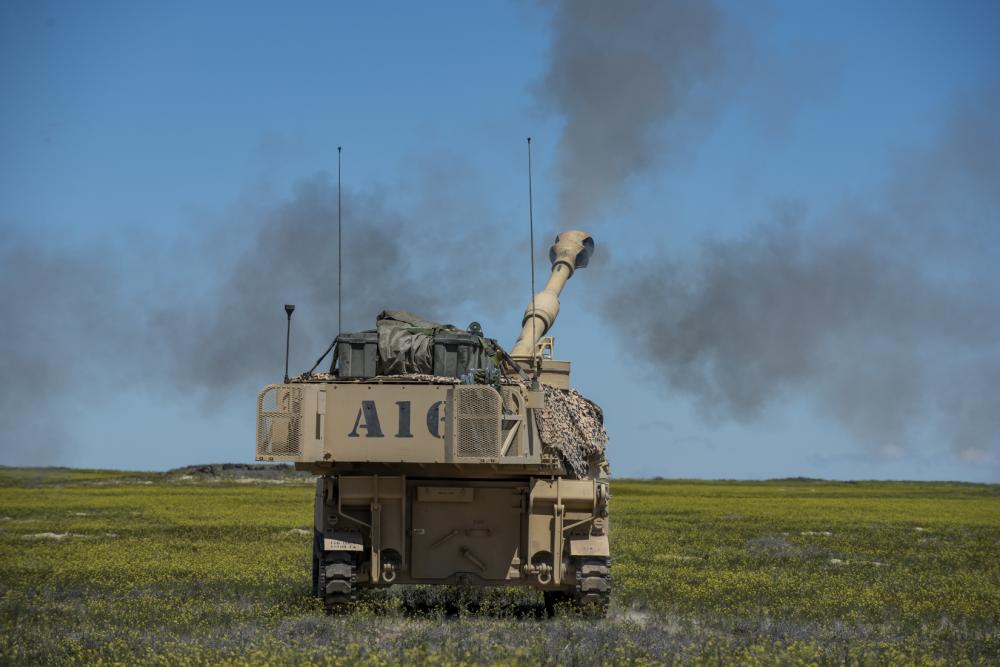
Crystal Farris/Idaho Military Division Public Affairs
The Idaho Army National Guard’s 1st of the 148th Field Artillery Regiment conducted its first-ever live fire training and certification using the U.S. Army’s modernized M1156 Precision Guidance Kit during the battalion’s annual training in the Orchard Combat Training Center May 12 to 27.
“The Idaho Army National Guard continues to receive and train on some of the military’s most modernized equipment so we can remain relevant and ready to defend our nation’s interest anywhere in the world,” said Brig. Gen. Farin Schwartz, commander of the Idaho Army National Guard. “The Idaho Army National Guard is one of the most modernized states in the Army National Guard, with equipment that enhances our capability to be interoperable with our active-duty peers.”
The modernized GPS guidance kit with fuze functions and integrated GPS receiver weigh three pounds and attach to existing 155mm artillery shells, converting them to smart weapons for improved target trajectory. Small aerodynamic fins on the fuze allow the system to make flight adjustments of the round’s trajectory and steer the shell on target.
This enables the 1-148th FAR to more precisely deploy munitions within 30 meters of an intended target, as opposed to the average 50 meters of traditional artillery, increasing the battalion’s lethality, while decreasing its spending costs, said Lt. Col. Brady Johnson, commander of the 1-148th FAR.
“Being PGK certified greatly increases the lethality of the field artillery battalion,” said Johnson. “The modernized weaponry allows 18 separate targets to be simultaneously targeted and attacked at a third the cost of conventional missions with minimal clearance of fire issues.”
Traditionally, the battalion would attack three enemy targets with a battery-sized element and six M109A6 Paladins, each firing three rounds of ammunition for a total of 18 rounds. Johnson said it costs approximately $20,000 for 18 rounds of conventional 155mm ammunition, which may or may not hit an intended target, whereas a PGK costs $6,500 per kit and will.
A fail safe can also prevent the shell from exploding if it falls outside 150 meters of an intended target, enabling Soldiers to more confidently call-in artillery support close to their position and reduce the possibility of collateral damage, said Sgt. 1st Class Mike Taylor, 1-148th FAR master gunner.
Soldiers first received training on the PGK when the battalion traveled to Camp Guernsey, Wyoming for annual training in July 2021 but were unable to conduct live fire with the precision guided munitions. Soldiers again received training on the PGK’s capabilities before conducting several live fire missions, first with conventional rounds and then with the PGKs.
Over 80 rounds were fired, including more than 50 PGKs, helping ensure the battalion’s ability to successfully perform its warfighting mission and certify using the modernized precision guided munitions.
“With the new technological advancements of today, it’s vital for us to be modernized,” said Taylor. “The 1-148th is really good at what we do, but with the new PGK, we are even better, hitting targets with every single round. This type of weaponry is going to be crucial on the current battlefield.”
The 1-148th FAR employs fire to destroy, neutralize, suppress or shape enemy forces; provides fire support to maneuver in close combat and during counterattack to control land areas; and provides counterfire.
It is equipped with the M109A6 Paladins that fire 155mm artillery shells. Crews that operate the Paladin consist of four-man teams; a driver, a number one man, a gunner and a section chief.
The number one man is responsible for loading and firing the weapon, the gunner fuzes the round and cuts propellant powder, while the section chief manages all firing data and ensures the weapon is laid on target.
MIA Soldier from Korean War identified and laid to rest in Idaho after 72 years
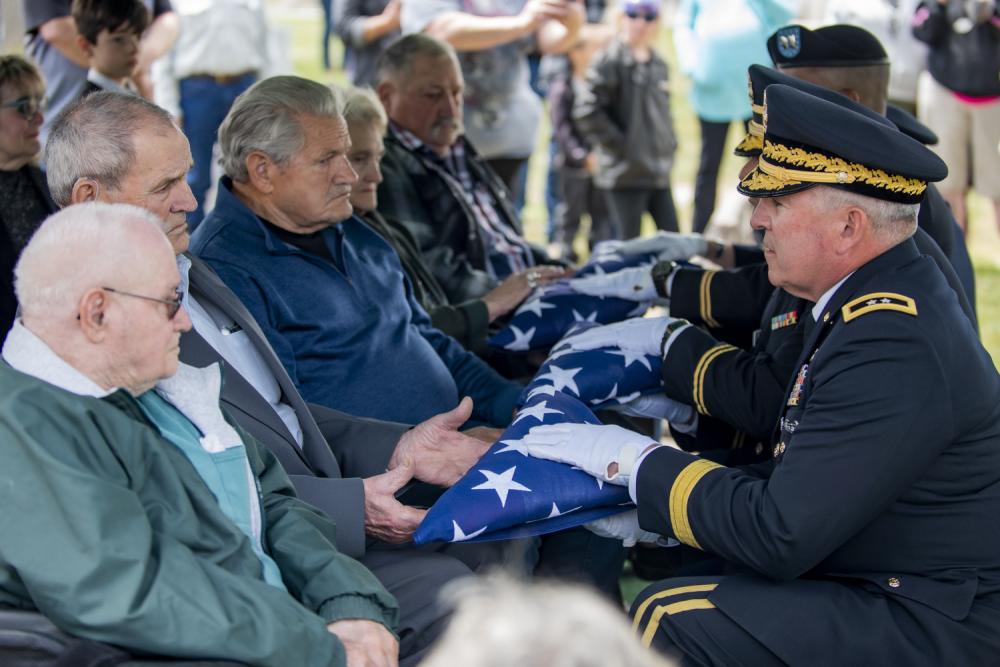
After 72 years, Pfc. Kenneth LeRoy Bridger was finally laid to rest and closure was given to his family during a full military honors graveside ceremony held in Twin Falls, Idaho, on May 21. Bridger was reported missing in action on Nov. 30, 1950, while serving alongside his fellow U.S. troops during the war against North Korea.
Bridger’s remains were identified on Jan. 26, 2022. Bridger was just 17 years old when he went missing and was a member of Company K, 3rd Battalion, 31st Infantry Regiment, 7th Infantry Division. He enlisted into the U.S. Army from Colville, Washington, but many of his remaining family resides in Idaho where he was laid to rest next to his brothers and his mother. Bridger’s four living siblings, along with their families, attended the private ceremony.
“Every U.S. service member is committed to never leave a fallen comrade behind. It is in our creed,” said Maj. Gen. Michael Garshak, Idaho’s adjutant general. “Although it has taken over 70 years to return Pfc. Bridger from the battle fields of Korea, it is comforting to me and to all who serve to know that we fight for a country that will never give up in keeping that promise. It is an immense honor to be a part of this ceremony and return Pfc. Bridger home to his final resting place with his family.”
Garshak presented Wilber Bridger, Pfc. Bridger’s brother and oldest surviving relative, the U.S. flag and the Purple Heart on his brother’s behalf. Bridger’s brothers Lynn and Halbert “Lee” Bridger along with his sister, Florence Fiscus, received the U.S. flag from the Idaho National Guard. The four siblings also received POW/MIA flags from the National League of the POW/MIA Families and local POW/MIA Awareness Associations in his honor.
Bridger was also awarded the Army Good Conduct medal, the National Defense Service Medal, the Korean Service Medal with three Bronze Service Stars, the Combat infantryman Badge, the United Nations Service Medal and the Republic of Korea-Korean War Service Medal.
The Idaho Army National Guard’s State Aviation Group performed a flyover with two UH-60 Black Hawk helicopters and the Idaho National Guard joint honor guard performed taps and the folding of the flag presentation.
Members of the Twin Falls community, lead by veterans, came together to honor and escort Bridger’s remains when they arrived to Idaho on May 17 in Twin Falls. According to the Defense POW/MIA Accounting Agency, Bridger was reported missing in action during the last night of his unit’s stand at the defensive perimeter south of the Pungnyuri Inlet on the east side of the Chosin Reservoir in North Korea.
Following an agreement between President Donald Trump and North Korean Supreme Leader Kim Jong-un, North Korea returned approximately 55 boxes containing the remains of U.S. service members on July 27, 2018. The remains were taken to Joint Base Pearl Harbor-Hickam, Hawaii, and entered into the DPAA laboratory for identification. One of the 55 boxes contained Bridger’s remains.
According to the DPAA, more than 7,600 Americans are still unaccounted for from the Korean War. Bridger’s name is recorded on the American Battle Monuments Commission’s Courts of the Missing at the National Memorial Cemetery of the Pacific in Honolulu, along with others who are still missing from the Korean War. A rosette will be placed next to his name to indicate he has been accounted for.
Idaho Army National Guard conducts joint medevac, casualty training

Crystal Farris/Idaho Military Division Public Affairs
Medics from the Idaho Army National Guard’s Headquarters and Headquarters Battery, 1st of the 148th Field Artillery Regiment conducted air medical evacuation and casualty treatment training alongside medical evacuation aviation assets at the Orchard Combat Training Center, May 17.
The training was supported by members of Detachment 1, Company Golf, 1st of the 168th General Support Aviation Battalion and several of its UH-60 Black Hawks, providing approximately 20 field artillery medics practice in air medevac scenarios while conducting their two-week annual training.
“I learned to stay calm and let the training I received in school take over,” said Spc. Regan Esplin, a 1-148th FAR medic. “I love being a medic, all the training that goes with it and everything about trauma medicine because it’s very immediate and the reward is you know how to save someone’s life. These kinds of experiences are crazy and not a lot of people get paid to treat casualties in a combat environment.”
For Esplin, the event was her first annual training with the battalion and a first opportunity to train with flight crews after graduating from the U.S. Army’s 68W Combat Medic Advanced Individual Training in 2021. During the event, she administered an IV and assisted other combat medics in stabilizing a patient.
During the training, combat medics had the opportunity to work with flight teams in loading patients into UH-60 Black Hawks, where they were evacuated from a point of injury to a Role 1 treatment facility. From there, medics offloaded patients from the aircraft and worked to evaluate, treat and stabilize them by administering tourniquets, IVs, ventilators and more prior to packaging them for transport to follow-on echelons of care.
“Training with medic and flight teams enable us to see how ready we are to respond to real-world situations and also make sure our newer medics get exposer to those situations in a tactical training environment first,” said Capt. David McDonald, a 1-148th FAR medical provider. “Depending on the situation, we may need to call in air medevac teams to transport our injured over long distances on the battlefield.”
In a tactical environment, the medical unit provides Role 1 care, which is the treatment a patient receives prior to surgical intervention, including self-aid, buddy-aid, tactical combat casualty care, tactical evacuation and medical evacuation, said McDonald.
When deployed in a tactical environment with the 116th Cavalry Brigade Combat Team, the battalion would coordinate the evacuation of patients to a Role 2 medical station, provided by the brigade’s Company Charlie, 145th Brigade Support Battalion. The Role 2 station offers surgeons, nurses, a pharmacy and short-term care.
1st Lt. Katherine Smith, executive officer with the medevac detachment, said its important combat medics receive training like this to become comfortable around aircraft in the likelihood they will have to work with them during a deployment. It’s equally important for members of her unit to train with combat medics so the two assets can ensure they understand each other’s operating procedures, she added.
“Different types of units that work together have to understand how the other operates,” said Smith. “In this case, the 1-148th combat medics need to understand how our pilots come into a landing zone and handoff a patient. What we need to know from them is at what point those medics need our assets to supplement that continuum of medical care.”
 Official Government Website
Official Government Website